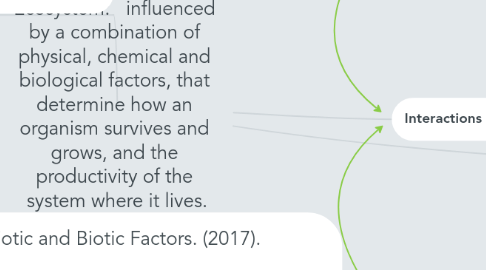Ecosystem: influenced by a combination of physical, chemical and biological factors, that determine how an organism survives and grows, and the productivity of the system where it lives.
by Martha Guerrero


1. References: Abiotic and Biotic Factors. (2017). Abiotic Transformation. (n.d.) Segen's Medical Dictionary. (2011). Retrieved August 8 2017 from Abiotic Transformation Biotic and Abiotic Factors. (2011). Burns, R. A. (2013) Fundamentals of Chemistry (4th Ed). Upper Saddle River, N.J: Prentice Hall J, D. (1991). Impact of wildlife on the environment. - PubMed - NCBI. Ncbi.nlm.nih.gov. Retrieved 9 August 2017, from https://www.ncbi.nlm.nih.gov/pubmed/1782418 Núñez, L., & Gutiérrez, M. (2017). No. 1_Topic_1_biotic_abiotic_17. Presentation.
2. Martha Grullón A01652771 502
3. CHANGES IN THE ECOSYSTEM
4. Interactions and transformations
4.1. Biotic-Biotic, EX: Bears need to feed on fish to survive so the population of fishes eventually decreases.
4.2. Abiotic-Biotic: EX: The sun and the rain make plants grow wich produce the oxygen other living organisms need to live
4.3. Biotic-Abiotic: EX: Herbivore animals such as rabbits need to eat plants to survive and then be eaten by predators making food chain.
4.4. MASS-MASS: EX: paper into ashes
4.5. Mass-energy, EX: The combustion of wood in a bonfire: wood changes producing heat and smoke
4.6. Energy-energy: Thermal Energy
5. MATTER
5.1. Mass: how matter exists in form of particles. It is the measurement of the quantity of matter that a body has.
5.2. Energy: Is the capacity to perform work or produce a change.
5.2.1. Kinetic energy: (movement)
5.2.2. Potential energy: (rest)
